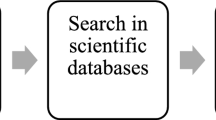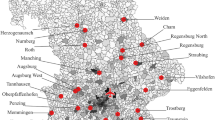Abstract
This study investigates the rescheduling behavior of pedestrians using airport services based on air passengers’ socio-demographic information and environmental attributes of the airport. It is a part of an overall project involving the development of an intermodal simulator for analyzing pedestrian traffic within intermodal facilities, which requires an understanding of pedestrian behavior. This paper presents a Multinomial Logit (MNL) model for simulating the rescheduling decision making behavioral responses of air passengers. A stated preference survey incorporating the use of a virtual 3D computer-graphic model is employed for data collection. The resulting data is then used for model estimation and validation. The empirical results show that the MNL model is able to predict air passengers’ rescheduling strategies.









Similar content being viewed by others
References
Bladel KV, Bellemans T, Janssens D, Wets G (2009) Activity travel planning and rescheduling behavior: empirical analysis of influencing factors. Transp Res Rec 2134:135–142
Chen C, Garling T, Kitamura R (2004) Activity rescheduling: reasoned or habitual? Transp Res Part F 7(6):351–371
Clark AF, Doherty ST (2010) A multi-instrumented approach to observing the activity rescheduling decision process. Transportation 37(1):165–181
Danalet A, Farooq B, Bierlaire M (2013) A Bayesian estimation of pedestrian activities using sensors data. In: ENAC Research Day 2013 (No. EPFL-POSTER-185830)
Doherty ST, Miller E (2000) A computerized household activity scheduling survey. Transportation 27(1):75–97
Doherty ST, Nemeth E, Roorda M, Miller EJ (2004) Design and assessment of the Toronto area computerized household activity scheduling survey. Transp Res Rec 1894:140–149
Ettema D, Timmermans H (2003) Modeling departure time choice in the context of activity scheduling behavior. Transp Res Rec J Transp Res Board 1831(1):39–46
Ettema D, Borgers A, Timmermans HJP (1994) Using interactive computer experiments for identifying activity scheduling heuristics. In: Proceedings of the 7th international conference on travel behavior, Chile, pp 13–16
Fruin JJ (1971) Pedestrian planning and design. Elevator World, Inc
Gangrade SACHIN, Pendyala RM, McCullough RG (2002) A nested logit model of commuters’ activity schedules. J Transp Stat 5(2/3):19–36
Garling T, Kalen T, Romanus J, Selart M (1998) Computer simulation of household activity scheduling. Environ Plann A 30:665–679
Greene WH (2002) Nlogit Version 3.0 Reference Guide. Econometric Software, New York
Hayes-Roth B, Hayes-Roth F (1979) A cognitive model of planning. Cogn Sci 3(4):275–310
Joh CH, Arentze TA, Timmermans HJP (2001) Understanding activity scheduling and rescheduling behavior: theory and numerical illustration. GeoJournal 53(4):359–371
Joh CH, Doherty ST, Polak JW (2005) Analysis of factors affecting the frequency and type of activity schedule modification. Transp Res Rec 1926:19–25
Lee MS, McNally MG (2001) Experiments with computerized self-administrative activity survey. Transp Res Rec 1752:91–99
Lee-Gosselin ME (2005) A data collection strategy for perceived and observed flexibility in the spatio-temporal organization of household activities and associated travel. In: Timmermans HJP (ed) Progress in activity-based analysis. Elsevier, Amsterdam, pp 355–371
Liu X, Usher JM, Strawderman L (2014) An analysis of activity scheduling behavior of airport travelers. Comput Ind Eng 74:208–218
Richter S, Ortmann C, Reiners T (2009) Passenger classification for an airport movement forecast system. In: Proceedings of the international multi-conference of engineers and computer scientists, Hong Kong, pp 676–683
Richter S, Voß S, Wulf J (2011) A passenger movement forecast and optimisation system for airport terminals. Int J Aviat Manag 1(1–2):58–69
Rindsfüser G, Mühlhans H, Doherty ST, Beckmann KJ (2003) Tracing the planning and execution of activities and their attributes—design and application of a hand-held scheduling process survey. In: 10th international conference on travel behaviour research, Lucerne (CD-ROM)
Roorda M, Andre B (2007) Stated adaptation survey of activity rescheduling: empirical and preliminary model results. Transp Res Rec J Transp Res Board 2021:45-54
Strawderman L, Lee H, Usher JM (2010) Utilization of behavioral studies in developing the intermodal simulator for the analysis of pedestrian traffic (ISAPT). Transp Plann Technol 33(3):281–295
U.S. Department of Transportation, Federal Highway Administration, 1996 National Household Travel Survey. http://nhts.ornl.gov
Watcharasukarn M, Krumdieck S, Green R, Dantas A (2011) Researching travel behavior and adaptability: using a virtual reality role-playing game. Simul Gaming 42(1):100–117
Yagi S, Mohammadian A (2008) Modeling daily activity-travel tour patterns incorporating activity scheduling decision rules. Transp Res Rec J Transp Res Board 2076:123–131
Acknowledgments
This project was sponsored by the US Department of Transportation (Grant No. DTOS59-06-G-00041).
Author information
Authors and Affiliations
Corresponding author
Rights and permissions
About this article
Cite this article
Liu, X., Usher, J.M. Modeling air passengers’ rescheduling strategies for airport service lines based on an empirical study with the aid of a virtual 3-D computer graphic environment. Public Transp 8, 57–84 (2016). https://doi.org/10.1007/s12469-016-0120-4
Published:
Issue Date:
DOI: https://doi.org/10.1007/s12469-016-0120-4




